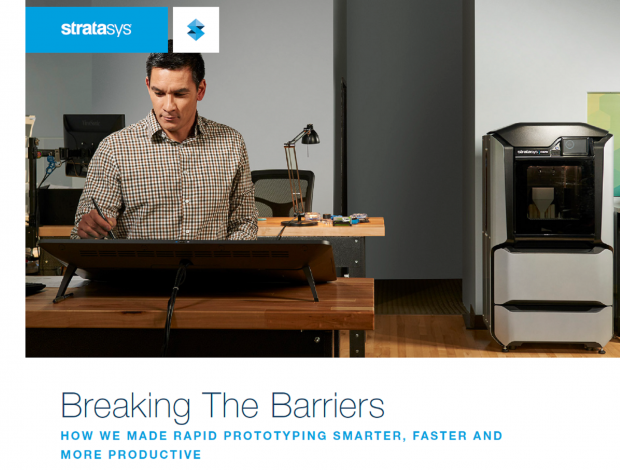Putting the Rapid into Rapid Prototyping
Latest News
May 24, 2018
Rapid prototyping (RP) technology is great stuff. The competitive benefits it can give your joint are legendary. But pundits often slide by some of RP's not so great characteristics, say slowness or complexity. The paper “Breaking the Barriers” explores many of the gotchas of older RP systems as well as many units available today and maps out point-by-point how the Stratasys F123 3D Printer Series overcomes them.
The paper looks at user complaints about RP systems with an eye toward practicality. After a brief recap of why RP has become a driving force in product design despite some technological drawbacks, it jumps right into the fray with a look at speed.
 The paper “Breaking the Barriers” looks into how the Stratasys F123 Series 3D printers resolve the challenges of rapid prototyping systems that have vexed designers, engineering and prototyping managers as well as top executives for 30 years. Image courtesy of Stratasys Ltd.
The paper “Breaking the Barriers” looks into how the Stratasys F123 Series 3D printers resolve the challenges of rapid prototyping systems that have vexed designers, engineering and prototyping managers as well as top executives for 30 years. Image courtesy of Stratasys Ltd.A slow RP system can frustrate your ability to fully test multiple design iterations. That can lead to expensive last-minute redesigns or service calls later. Based on FDM (fused deposition modeling) technology, the F123 series addresses design iteration speed beginning with multiple material options and the flexibility to 3D print concept verification and design validation models quickly. For example, it has a Fast Draft print mode that runs at twice the speed of the standard print operation while using way less material.
But slowness also stems from complexity. That can mean dedicated workrooms, unwieldy workflows and expert staff to manage the thing. None of these are issues with the F123 series, the paper notes. For one, they're office friendly. No nasty chemicals or materials. They operate on standard 110-volt power. They are Wi-FI workgroup-ready, and are as quiet as a home refrigerator.
Two, they're plug-and-play. No expertise required. Loading materials sounds fast and painless. No calibration required. Three, Stratasys' GrabCAD software enables designers to create (or import) and prep models for 3D printing in a familiar CAD-like environment, then hit print like you do for a paper printout.
What does this mean regarding the big issue—money? Stratasys describes how it developed the F123 series using many technologies that the series leverages. Example: Over 20 iterations of a new print head design and 80 head housings were 3D printed during the design development and verification stage. What would it cost you to injection-mold 80 different prototypes?
If you've dithered about integrating RP into your workflow or if past experience makes you leery of investing in the latest generation of the technology, the paper “Breaking the Barriers” should ease your concerns. Hit the link to download your copy.
Thanks, Pal. – Lockwood
Anthony J. Lockwood, Editor at Large, DE
More Stratasys Coverage
Subscribe to our FREE magazine, FREE email newsletters or both!
Latest News
About the Author
Anthony J. Lockwood is Digital Engineering’s founding editor. He is now retired. Contact him via [email protected].
Follow DE







